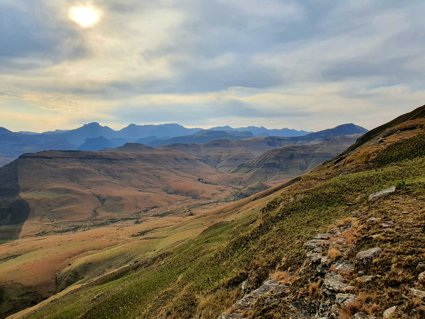
Lesson one: Case study
Key questions
What was the Last Glacial Maximum (LGM)?
How was the climate of the High Drakensberg different from today during the LGM, and how extensive was glaciation in the Drakensberg at this time?
How can these questions be answered through geographical fieldwork?
Aims
To learn about the LGM, review key terminology relating to glacial and periglacial environments, and build an A-level case study of a previously glaciated environment where climate was very different in the past compared to what it is today. To include:
-
Information about the LGM with an overview of how different the world’s climate was at the time
-
A review of the main types of glacial and periglacial features
-
The present-day location, climate and environment of the Drakensberg
-
The climate of South Africa in general and relation to ocean current
-
An introduction into geographical research on past glaciation and past climates inspired by the research of Dr Stephanie Mills in the High Drakensberg
This lesson supports teaching of climate change over long timescales and the evidence for it, of how the distribution of cold environments has changed through time, and of the process of geographical research.
Starter
Look at any of these web links and view the PowerPoint slide show about the LGM
Use the links and PowerPoint slides to provide answers in note form to the following questions:
-
What was the Last Glacial Maximum?
-
When did the LGM occur?
-
How were the climate and environment different during the LGM?
-
What happened to the world’s oceans during the LGM?
-
How do you think the Northern Hemisphere and Southern Hemisphere compared during the LGM and why?
-
What has happened to the Earth’s climate since the LGM?
Main Activity
Before looking specifically at the High Drakensberg today and how it may have been during the LGM, the next task is to review some of the terminology and concepts that are related to glacial and periglacial environments and the landforms, deposits, and other features that are produced in such environments.
Review of glacial and periglacial terms and concepts
The terms and definitions document contains a glossary of terms and definitions which are out of order. The first activity is to match the correct definitions with the correct terms, and the second activity (if time) is for each member of the class to take one term and definition and to find a partner.
Quiz your partner on the definition for the term. Your partner should then use their term to quiz you. After you have quizzed each other, swap your term and definition and each of you must find a different person to quiz with your new definitions. Eventually you will have quizzed (or been quizzed on) most of the definitions.
Overview of the present-day climate and environment of the High Drakensberg
Form groups of three and work together to produce a ‘briefing document’ summarising the present-day Drakensberg environment. Watch the video clip and scroll through the sequence of PowerPoint slides to gather your information. Note down any facts and statistics where you can, but simple description is fine too.
Each member of the group is responsible for one of the following:
-
The location of the Drakensberg and its terrain and general characteristics
-
The geology and geomorphology (landforms) and plant and animal life
-
The climate and related ocean characteristics off the southeast coast
Now pool your information inside your group to complete your summary document.
Plenary
How can we use what we’ve learned so far to develop a geographical investigation on glaciation and past climate of the Drakensberg?
Discuss the following questions in your groups of three, and report back your answers to the rest of the class.
-
What do you think the climate of the High Drakensberg would have been like during the LGM compared with today?
-
What evidence would you look for in the Drakensberg to test your views about the climate there during the LGM?
-
The extent of past glaciation in the Drakensberg is neither as well studied nor as well known as past glaciation in the British Isles. Can you suggest any reasons why?
-
Why do you think it would be useful to investigate evidence for glacial and periglacial activity in the Drakensberg?
-
What is the wider relevance of such research to our understanding of climate change in general? (Hint: think of links between other parts of the world’s climate system, such as oceans)
For further information about the nature of Dr Mills’ study and its wider relevance, read the researcher Q and A document in which she answers some questions about her research.
